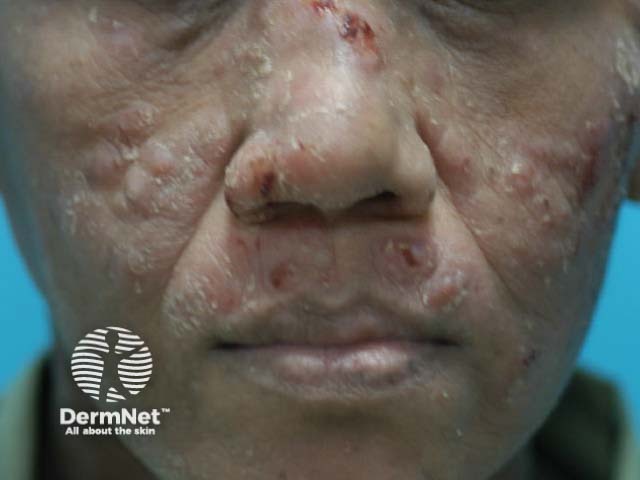Main menu
Common skin conditions

NEWS
Join DermNet PRO
Read more
Quick links
Author: A/Prof Felix Boon-Bin Yap, Dermatologist, University Tunku Abdul Rahman and Sunway Medical Centre, Selangor, Malaysia. DermNet Editor in Chief: Adjunct A/Prof Amanda Oakley, Hamilton, New Zealand. Copy edited by Gus Mitchell. Revised October 2020.
Introduction
Demographics
Causes
Clinical features
Complications
Diagnosis
Differential diagnoses
Treatment
Outcome
Talaromycosis is an infection caused by the thermally dimorphic fungus Talaromyces marneffei. The condition was originally called penicilliosis after the organism was called Penicillium marneffei; the fungus was reclassified in 2011.
Talaromycosis is seen almost exclusively in immunocompromised children and adults. Infection was initially identified in HIV/AIDS patients in tropical areas of Southeast Asia in the late 1980s and 1990s. Talaromycosis was classified as an AIDS-defining infection and one of the HIV clinical stage 4 conditions. It has also been reported to develop during the immune-reconstitution syndrome (IRIS).
Endemic countries include Vietnam, Thailand, the Philippines, Taiwan, Hong Kong, southern China, and India. Travellers have presented with talaromycosis in many non-endemic countries including Australia, the United States, Europe, and the United Kingdom.
With antiretroviral treatment (HAART), talaromycosis is now increasingly recognised in HIV-negative patients. Infected adults may have known associated conditions including:
HIV-negative children with talaromycosis should be suspected to have an underlying immunodeficiency syndrome if secondary immunosuppression has been excluded. Talaromycosis has been reported in children with:
It has been suggested there may be a genetic susceptibility to infection with HLA-associations reported particularly in people of Southeast Asian descent.
Talaromycosis is caused by Talaromyces marneffei, a fungus found in wild bamboo rats, their faeces, and the soil around their burrows. Infection of humans mainly occurs in the rainy season following inhalation of conidia from agricultural soil. Acute infection has an incubation period of 1–3 weeks, but reactivation of latent infection may present years later.
Talaromycosis can present as a local or disseminated infection. It is primarily a lung infection where it may remain localised.
Systemic features of disseminated talaromycosis include:
Skin lesions are common in HIV/AIDS-associated talaromycosis (70%) and are often the presenting sign. The characteristic lesions are papules with central necrosis or umbilication scattered over the head and upper chest. Nodules, subcutaneous abscesses, pustules, cysts, and ulcers may occur.
The skin lesions are often atypical in IRIS-associated talaromycosis with verrucous (warty) lesions, red papules, or plaques seen.
In non-HIV-associated talaromycosis, the skin is involved in 40% of cases and may present with reactive rashes such as Sweet syndrome.
Skin lesions are uncommon in HIV-negative children with talaromycosis.

Facial nodules with talaromycosis
Diagnosis of talaromycosis is often delayed, particularly in HIV-negative patients from non-endemic countries. The disease course is rapidly progressive once infection has disseminated.
Disseminated talaromycosis can involve the bone marrow, causing anaemia and thrombocytopenia, and the bones and joints, resulting in osteolytic lesions. In HIV-positive patients, talaromycosis is often associated with other opportunistic infections, such as tuberculous and non-tuberculous mycobacteria, which may obscure and delay diagnosis.
General screening blood tests typically show a leukocytosis with neutrophilia, anaemia, thrombocytopaenia, and elevated C-reactive protein (CRP) and ESR. Liver enzymes may be disturbed.
Chest X-ray may show pleural effusions, nodules, infiltrates, and cavitation.
Diagnosis of talaromycosis requires demonstration of the organism. This can be achieved in the following ways.
Once talaromycosis has been confirmed, investigations should be directed at identifying an underlying predisposing cause if not already apparent.
The differential diagnosis of the skin lesions of talaromycosis depends on the lesion morphology.
Intracellular fungi on histology may be confused with histoplasmosis.
Systemic antifungal drugs are required to treat talaromycosis, with initial high dose therapy followed by prolonged maintenance over many months. Amphotericin B, itraconazole, and voriconazole are the usual agents prescribed.
Prophylactic treatment should be considered for high-risk individuals planning to travel to endemic countries.
Talaromycosis can be rapidly progressive with a high mortality rate if untreated. Even with treatment, it is often fatal; children 55%, HIV-negative adults 30%, and HIV-positive adults 20%.